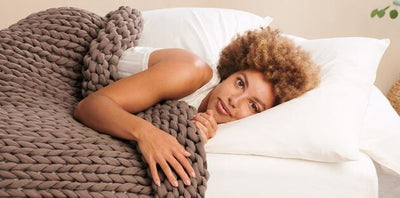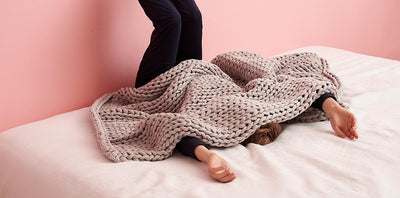What Is REM, And What Does Your Napper Have To Do With It?
Sleep is important—there’s no getting around it. Although we know sleep is crucial to our daily health and happiness, many of us don't really understand how it works.

Bearassentials
Our sleep cycles are well-designed by nature to repair our brains overnight, which is why we need to go through all 5 sleep stages to feel completely rested and restored come obnoxious alarm ring.
REM sleep, aka rapid eye movement, is when we experience most of our dreaming, and exists at the end of each sleep cycle. Drinking alcohol before bed tends to impair your ability to make one’s way to REM slumber.
Weighted blankets can effectively reduce restlessness and increase your production of serotonin and melatonin, which will improve your quality of rest, and in turn your quality of life!
Did you know?
Within 5 minutes of waking up, over half of your dreams are already forgotten. If you’re into it, try keeping a dream journal by your bed to remember them… or don’t and let them be forgotten.
Sleep is important—there’s no getting around it. While some people can manage to squeak by on just a few hours of snoozin’, most of us require the full 8-ish hours. We all know the negative feels from failing to get enough rest: brain fog, crankiness, a shortened attention span. Add in some undereye circles and a cup of coffee permanently stuck to your hand, and your symptoms are recognizable to just about everybody.
Although we know sleep is crucial to our daily health and happiness, many of us take it for granted. And most don’t fully understand what the cycles of sleep are, their true importance and the complexities behind them. Read on to learn the intricacies and significance behind this magical thing that the routinely rested enjoy for one-third of their lives.
Sleep Cycles: The Basics
We have 5 sleep stages that we cycle through every night—each stage varying in length and totaling about 90-120 minutes per cycle. Most of the stages are N-REM, aka non-rapid eye movement, with just one stage being REM. Both types of stages are essential as you can’t function for too long on just one or the other. Having said that, let’s get into the nitty-gritty:
Stage 1: This is the lightest stage of N-REM sleep. Think drowsy, half-asleep time, when someone can wake you up easily and you’ll swear you were never even asleep. You may also experience that falling sensation that jolts you awake—you know the feeling!
Stage 2: Also N-REM sleep, this stage gets a little deeper but is still technically “light” sleep. About half of your night is spent snoozing in this stage. Your breathing becomes slower, and you become much more relaxed. You’re approaching that deep, deep sleep, commonly known as slumber.
Stages 3 and 4: These 2 are considered DEEP N-REM sleep. In these stages, you’re pretty much dead to the world for a period of time. If you wake up in the midst of stage 3 or 4, you’ll likely feel pretty groggy, so the idea is to continue through them without interruption. (Fun fact: this is why power naps of about 20 minutes work so well if you wake up before this stage kicks off.) Your brain is getting rejuvenated and restored during these stages of shuteye. Sleepwalking, sleep talking, and night terrors occur most often during this sleep realm because while your brain is shut off, your body isn’t (you’re actually kind of like a zombie). The 2 stages are grouped together because they’re both considered “slow-wave sleep”.
Stage 5: Finally, we’ve made it to REM sleep, which usually occurs about 90 minutes after you actually fall asleep. This is where the majority of your dreaming occurs, and your eyes may twitch or dart around under your eyelids (hence the name). While the eyes move, the rest of your body doesn’t as your limbs are temporarily paralyzed during REM. This is a good thing being that it protects us from physically acting out your dreams (things could get scary/creepy if we did!). In this final sleep stage, our brains are active but our bodies are shut down and immobile (opposite of zombie mode). The cycle is complete, and you’re ready to start it over again or wake up.

Why REM Rules
REM is a special stage of sleep because it’s needed to consolidate memories from the day and store them in your long-term memory bank. It’s also important for learning and brain development, especially for babies and tots. Some specialists consider REM the deepest sleep, while others put REM in its own class altogether. People who don’t make it to REM sleep tend to be more overweight, more susceptible to migraines, and possess minimized coping skills, along with a lack of emotional control.
Since almost all of our dreaming happens in REM sleep, and given it’s at the end of our sleep cycle, we tend to wake up naturally at the end of a dream. However, when we bring alarm clocks into the mix, it’s hard to predict when the end of your sleep cycle will occur and because of this, we run the risk of waking up in the midst of our deep sleep stages, where crankiness and grogginess often ensue.
Relax Your Way To REM
Now, you may be wondering how to get to REM as quick as you can. After all, we all tend to enjoy dreaming (well, most of the time). Our bodies are pretty smart—the first sleep cycle is the shortest as its intent is to ensure it delivers a complete full cycle before you wake. Then, as the night goes on, the cycles get longer and longer. But some things can mess with our cycles. A boozy nightcap can make it seem like we fall asleep faster, although it’s much harder to get into both deep and REM sleep when we imbibe before bed. We’re not encouraging day drinking or anything, but if you’re going to have a drink, do it at least a few hours before bedtime.
Apart from laying off the sauce, you can speed up your sleep cycles by stimulating snoozy hormones and relaxation. The answer? Weighted blankets (duh!). Our heavy-knit Nappers work by utilizing Deep Touch Pressure (DTP), which activates various pressure points on the body to induce relaxation. DTP leads to an increase in serotonin and melatonin, both of which promote rest and sleep. This natural cocktail of healthy hormones married with the pressure on your body leads to less movement (diminished tossing and turning) while you’re trying to drift into Dreamland. This combination leads to more time in both deep sleep and REM sleep, meaning you’ll wake up feeling refreshed and ready to take on the day.







